Artisan Bread Bowls
These homemade Artisan bread bowls are hearty and dense and perfect for scooping out, and filling up with a delicious, comforting soup.
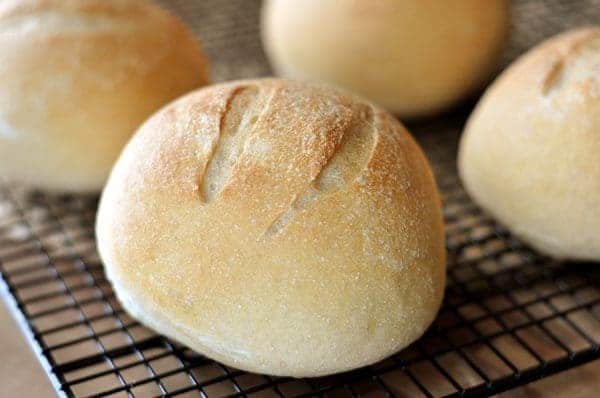
These Artisan Bread Bowls are one of two favorite bread bowl recipes (the other is here).
They are hearty and dense and perfect for filling up with a delicious, comforting soup.
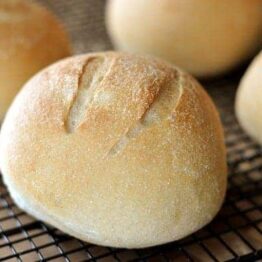
Artisan Bread Bowls
Ingredients
- 3 ¾ cups (533 g) all-purpose flour (see note)
- ½ cup (71 g) whole wheat flour
- ¼ cup nonfat dry milk
- 2 teaspoons yeast
- 2 teaspoons salt
- 2 tablespoons oil
- 1 ½ cups lukewarm water, enough to make a smooth, soft dough
Instructions
- Let yeast dissolve in warm water until creamy, about 5 minutes. Add the rest of the ingredients—by hand, mixer or bread machine— and knead till you’ve created a smooth dough.
- Allow the dough to rise, covered, for 45 minutes; it should become puffy. Divide the dough into 5-6 pieces, depending on how large you want your bread bowl to be. Roll each piece into a ball. Place on a lightly greased or parchment covered baking sheet.
- Cover the bread bowls with greased plastic wrap. Refrigerate for 4 hours (or up to 24 hours); this step will give the bread bowls extra flavor, and a delightfully crisp-chewy texture.
- Two or more hours before serving, remove the bread bowls from the refrigerator. Uncover, and let them sit for about one hour while you preheat the oven to 425°F.
- Just before baking, slash the top surface of the bowls several times with a sharp razor/knife to allow them to expand.
- Bake for 22 to 28 minutes, until the bowls are deep brown, and sound hollow when thumped on the bottom. Remove from the oven, and cool on a rack.
Notes
Flour Amount: as with all yeast doughs, I never use the flour amount called for in the recipe as a hard fast rule (unless a weight measure is given and then I pull out my kitchen scale). Because humidity, temperature, altitude and a multitude of other factors can impact how much flour you need in your yeast doughs, I always judge when to quit adding flour by the texture and look and feel of the dough rather than how much flour I’ve added compared to the recipe.
Tutorial: This tutorial on yeast may help identify how a perfectly floured dough should be.
Whole Wheat Flour: also, I often use half to 3/4 finely ground white whole wheat flour with good results – and sometimes I get crazy and use 100% whole wheat flour (always finely ground white wheat) but the bread is a bit more dense with 100% whole wheat flour. If using part or all whole wheat flour, add a few minutes to the kneading time to help develop the gluten.
Serving: 1 Bowl, Calories: 470kcal, Carbohydrates: 85g, Protein: 16g, Fat: 7g, Saturated Fat: 1g, Cholesterol: 1mg, Sodium: 969mg, Fiber: 5g, Sugar: 4g
Recommended Products
Recipe Source: adapted from King Arthur Flour
Disclaimer: I am a participant in the Amazon Services LLC Associates Program, an affiliate advertising program designed to provide a means for me to earn fees by linking to Amazon.com and affiliated sites. As an Amazon Associate I earn from qualifying purchases.

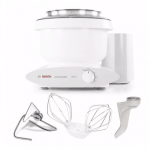
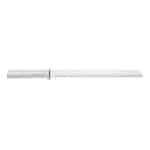
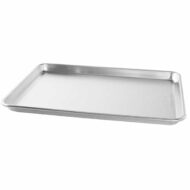
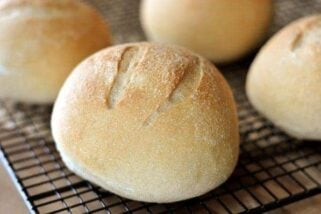
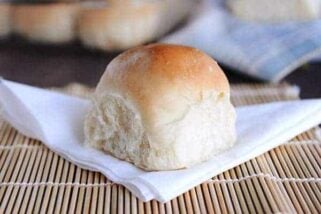
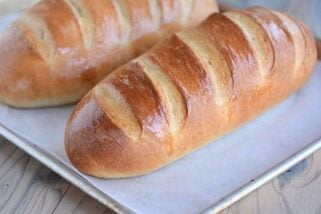
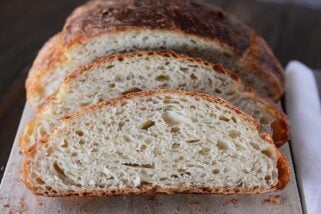
Needs to have the Nutrition facts included.
Is the yeast listed in this instant or active dry? I only have instant on hand, does that affect yeast amount? Thanks!
You can use either in this recipe.
I’m making these for a family get together tomorrow. We will have other food so I was thinking we wouldn’t need full size bowls. I made 10 out of each batch, about 3.5 oz each. How long should they sit out before I bake them… it’s says take them out of the fridge 2 hours or more and also says to let sit one hour while preheating? Also how long do you think I should bake them? I was thinking I would check them about 12-15 minutes?
I just take them out in time for the to come to room temperature and get slightly puffy (so they aren’t too dense). I’d bake them about 15-16 minutes.
I don’t have any dry milk on hand. If I want to sub in 2% milk, would I replace the entire 1.5 cups of water with milk or would I only replace 1 cup of water with 1 cup of milk and add the remaining .5 cup as water? And if I do replace with milk, do I need to scald the milk first? Thanks for the help!
Yes, I’d scald the milk (it helps for a more tender dough) and I’d probably use all milk in place of the water.
I tried a different bread bowl recipe… And first of all… It came out more flat than rounded… Do these maintain a round shape…you know…like a bowl?
Also the other one had a sour yeasty taste. I hope these turn out better!!! I will follow up!
If the dough is well-floured, they should maintain a really nice round shape. Good luck!
Can I use all purpose flour for the full amount instead of 1/2 cup whole wheat?
Sure.
Can these be made and and frozen?
Love your site, btw!
Hi Linder – yes, these freeze great!
Do you freeze them cooked already?
Excited to try them out!
Laura – Yes, I freeze them once they have baked and cooled.
These are awesome! My kids get to shape their own bowl for dinner. How fun and tasty!
Thank you so much for this recipe. These bread bowls turned out amazing and I will definitely be using this recipe from now on.